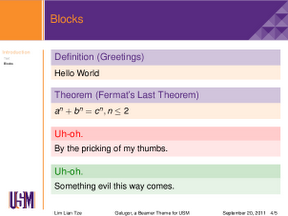A question on TeX.SX about “How is LaTeX used in industry and what are some examples?” has garnered over 6k views since posted yesterday. I had mentioned during my MOSC talk that LaTeX would be very useful in scenarios where some printable content has to be batch-generated or on-the-fly, and now some actual real life examples are given in the answers.
For example, this website allows users to query transportation timetables and returns the results as a pdfTeX-generated PDF:
And here’s another schedule generated by another German transportation website (PDF):
If you read the other answers, you’ll see what and how LaTeX is used in other companies (besides academic publishers). For example, this answer by Peter Flynn:
As a LaTeX consultancy, we have produced classes and styles for many organisations, including companies, government departments, and non-profits. A London auction house uses LaTeX to generate invoices; an electronic systems training company uses LyX and LaTeX to create their course workbooks and white papers; a Dublin printer uses LaTeX for pharmaceutical labelling; a local government organisation uses TeX to generate the Register of Voters; a professional scientific association uses LaTeX for its regular series of technical reports; and of course we use it internally for client reports, newsletters, and invoicing.




















